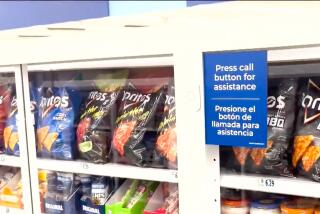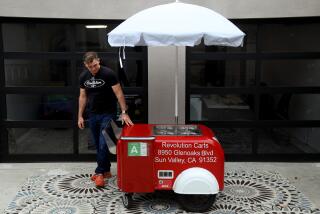Becoming a Runaway Success : 5th Wheel Reins In Escaping Baskets
- Share via
A San Diego company may have shopping cart thieves running in circles, thanks to a relatively new device that clamps onto the cart and sends it “in a circular pattern only” when activated.
Although the company, KartGuard Internationale, calls its product the “5th Wheel System,” President Ray Calhoun contends that the gadget is giving new meaning to the phrase “fifth wheel” because it is definitely useful to the grocery industry, which loses millions of dollars worth of shopping carts every year.
“Not all fifth wheels are necessarily bad,” Calhoun said. “We have been successful in every installation.”
Grocery stores typically save between $1,000 and $1,500 a month, and “that’s a very substantial saving when you think of the margins that supermarkets are operating on,” he said.
KartGuard, which has annual sales of about $1 million, has been selling its 5th Wheel System for about a year and has installed it on carts in 25 grocery and other stores in California. Alpha Beta, Lucky Stores, Safeway and Vons are among the chains testing the product in some of their highest cart-loss stores.
“It’s working well,” said Bill Wade, senior vice president of Los Angeles-based Alpha Beta. As for the customers, “they usually don’t notice it.”
Here’s how the system works.
If someone tries to roll a cart off the supermarket’s parking lot, the fifth wheel drops into place and locks at a 45-degree angle. Until deactivated by a special magnetic wand, that cart will travel in small circles.
“You should see people’s faces when the cart goes around and around in little circles,” one checker at a Vons store in Santa Monica told a customer. “It’s almost as good as spraying yellow dye on their hands.” Vons recently began testing the KartGuard device.
The KartGuard wheel is only the grocery industry’s latest weapon in its fight against shopping cart theft, said Don Beaver, president of the California Grocers Assn.
“There’s all kinds of things that have been tried in the past, and nothing is foolproof,” Beaver said.
A few grocers tried placing electrical devices around the perimeters of their parking lots that caused the wheels of specially designed carts to lock as they passed, but thieves found they could lift the carts over the electrical field, he said. Some stores have installed barriers that forced shoppers to carry their bags to their cars.
Probably the most visible device is a machine that gives the customer 25 cents when he or she returns a cart--but only after a 25-cent deposit is put on the shopper’s bill at the checkout stand.
Smarte Carte of White Bear Lake, Minn., has such machines in 45 grocery stores in California and one in Hawaii, said Ruth Petermann, a company salesperson. The coin machine has been available locally for more than two years. The company has similar machines in airports for luggage carts.
The California Grocers Assn. has been attacking the problem of shopping cart theft since 1982, when it introduced a hot line for reporting abandoned carts and began publicizing the cost to consumers, Beaver said. It is illegal to take a shopping cart from the store’s parking lot without written permission.
“These carts . . . cost about $125 apiece, and they end up in your grocery bill somewhere because it’s a cost of doing business,” Beaver said.
Since that cart roundup began, losses by state grocers have fallen to about $4 million a year from $14 million, not counting the cost of hiring crews to retrieve lost carts, Beaver said.
Carts often are taken by elderly shoppers who need help getting their purchases home but then abandon the carts, Beaver said.
But shopping carts also are stolen by theft rings who sell them to coin-operated laundries, garages and other businesses or peddle them in Mexico. The Sacramento trade group even found 16 shopping carts being used by electricians in the Capitol building “right under our nose,” Beaver said.
KartGuard’s Calhoun said customers sometimes are mystified by the operation of the fifth wheel. At one store where the product was installed recently, a woman asked him how the cart “knew” it was leaving the parking lot.
“I told her it was like the story of the Thermos--how does the Thermos know whether it has something hot or cold (inside)? How does it know which way to keep it?” he said with a laugh. “She just scratched her head and walked away.”
Actually, the fifth wheel is spring-loaded and shoots down whenever the front wheels are raised. KartGuard often installs a speed bump around the edge of a store’s parking lot to ensure that the wheels raise if someone tries to leave the lot.
Sometimes it backfires.
A heavyset man was witnessed activating the fifth wheel on his cart when he rested on the cart’s handle while waiting near the checkout stand at the Vons store in Santa Monica. He ended up carrying his cart to the checker.
Retailers generally receive few complaints about the fifth wheel, and some alternative anti-theft devices could have big drawbacks, Calhoun said.
“There are some retailers who suggested explosive devices that would detonate once they got beyond a certain range, but that could have a negative market impact,” Calhoun quipped.
More to Read
Sign up for Essential California
The most important California stories and recommendations in your inbox every morning.
You may occasionally receive promotional content from the Los Angeles Times.










